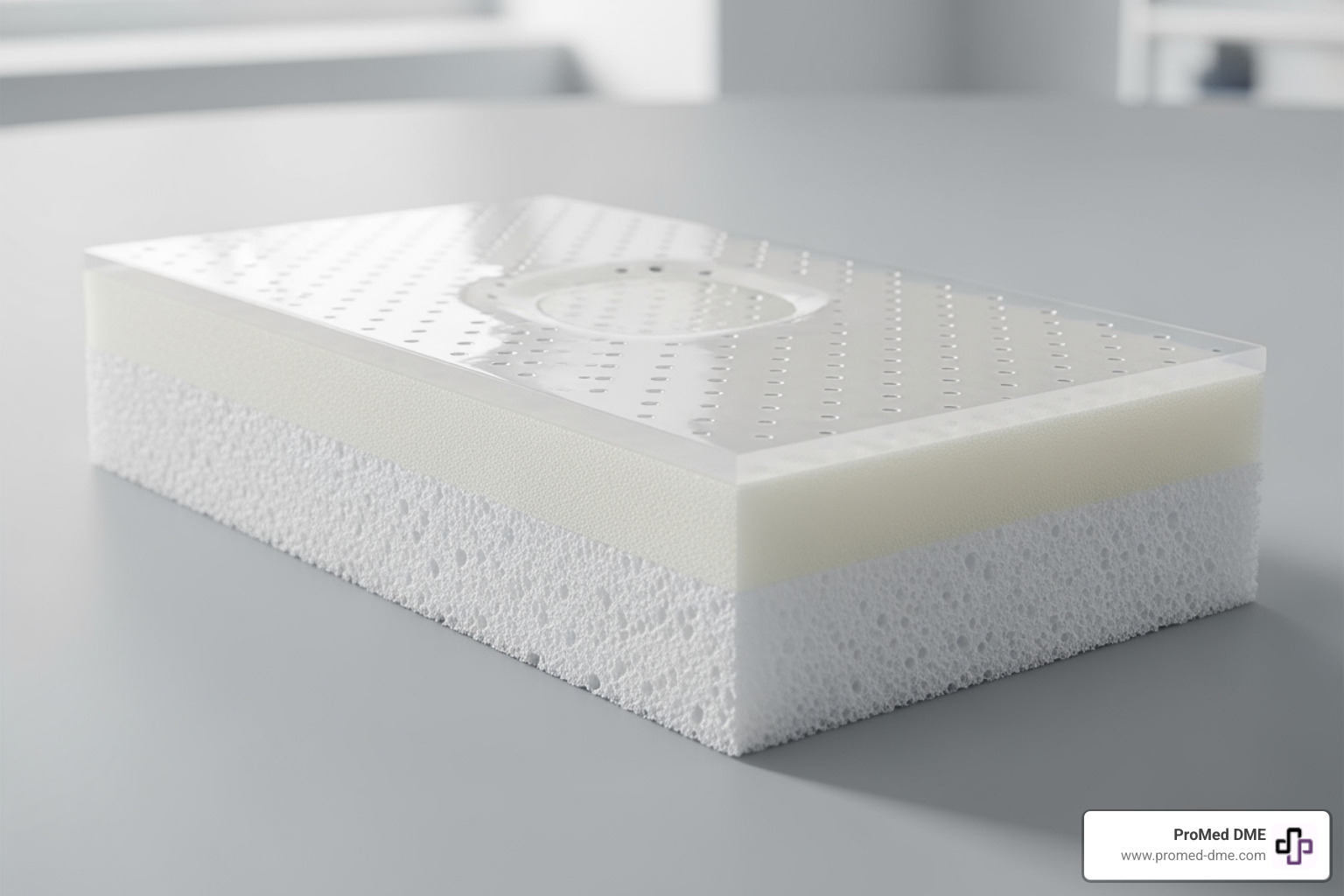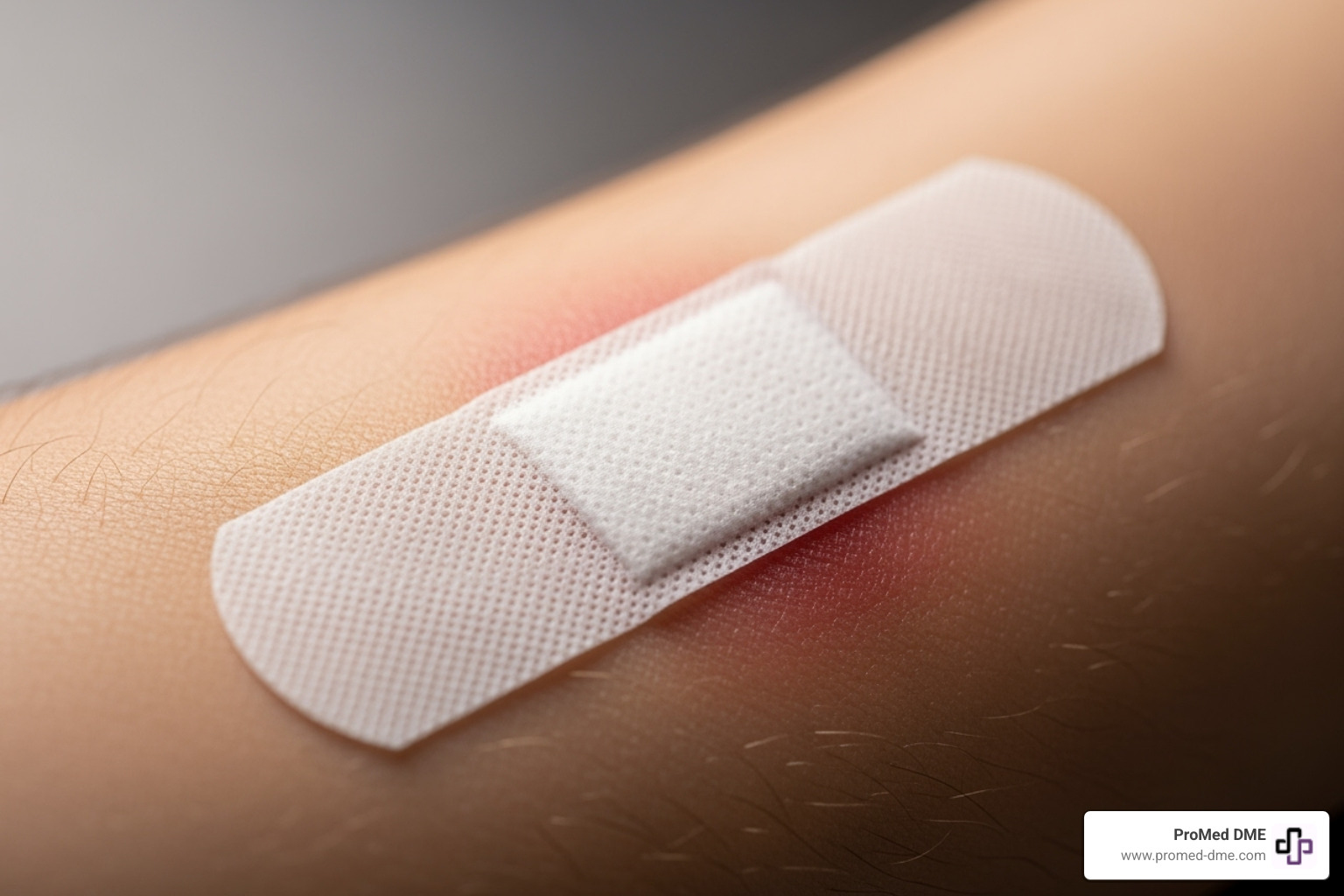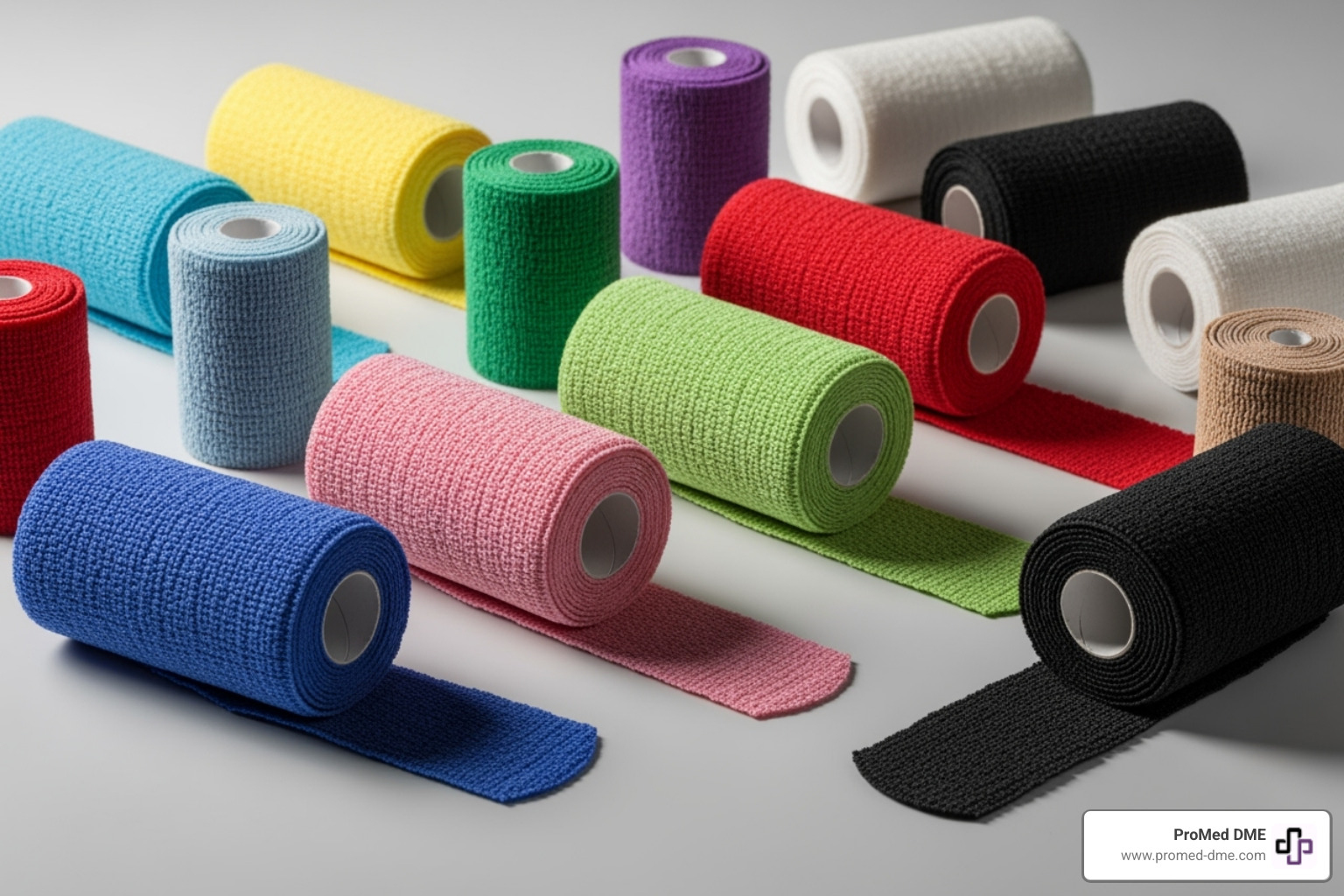The Blue Hue for You: Top Cohesive Bandages Reviewed
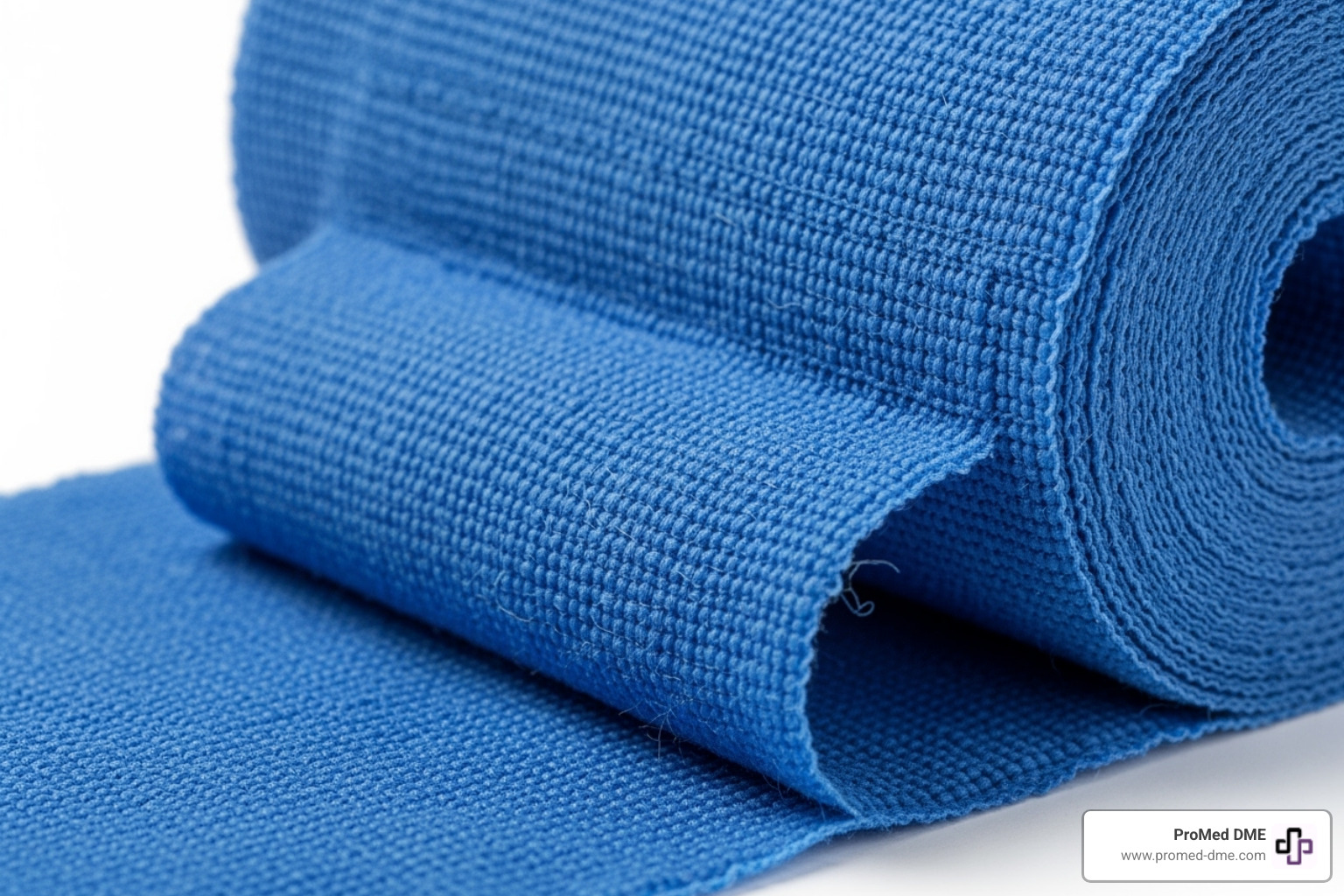
What Makes Blue Cohesive Bandages Essential for Safe Wound Care
A blue cohesive bandage is a self-adherent wrap that sticks to itself but not to skin or hair, making it ideal for securing dressings, supporting injuries, and providing compression without the pain of removal.
Quick Facts About Blue Cohesive Bandages:
- Self-adherent: Sticks only to itself, never to skin
- Hand-tearable: No scissors needed for application
- Latex-free options: Safe for sensitive skin and allergies
- Water-resistant: Maintains hold even when wet
- Detectability: Blue color makes it easy to spot in food service environments
- Reusable during single application: Can be repositioned before final placement
Blue cohesive bandages differ from traditional adhesive bandages in one key way: they use a blend of non-woven fibers and methacrylate adhesive that creates a mechanical bond with itself. This means you get reliable compression and support without the sticky mess or painful removal that comes with tape-based products.
The blue color isn't just for looks. In food service, veterinary clinics, and medical facilities, blue bandages provide visual detectability - making them easy to spot if they accidentally fall off during work. This safety feature has made blue the preferred color in commercial kitchens, restaurants, and food processing plants.
Whether you're dealing with a sprain, securing a wound dressing, or need reliable compression for swelling, these versatile wraps offer the perfect balance of hold and comfort. They're lightweight, breathable, and can be torn by hand to exactly the size you need.
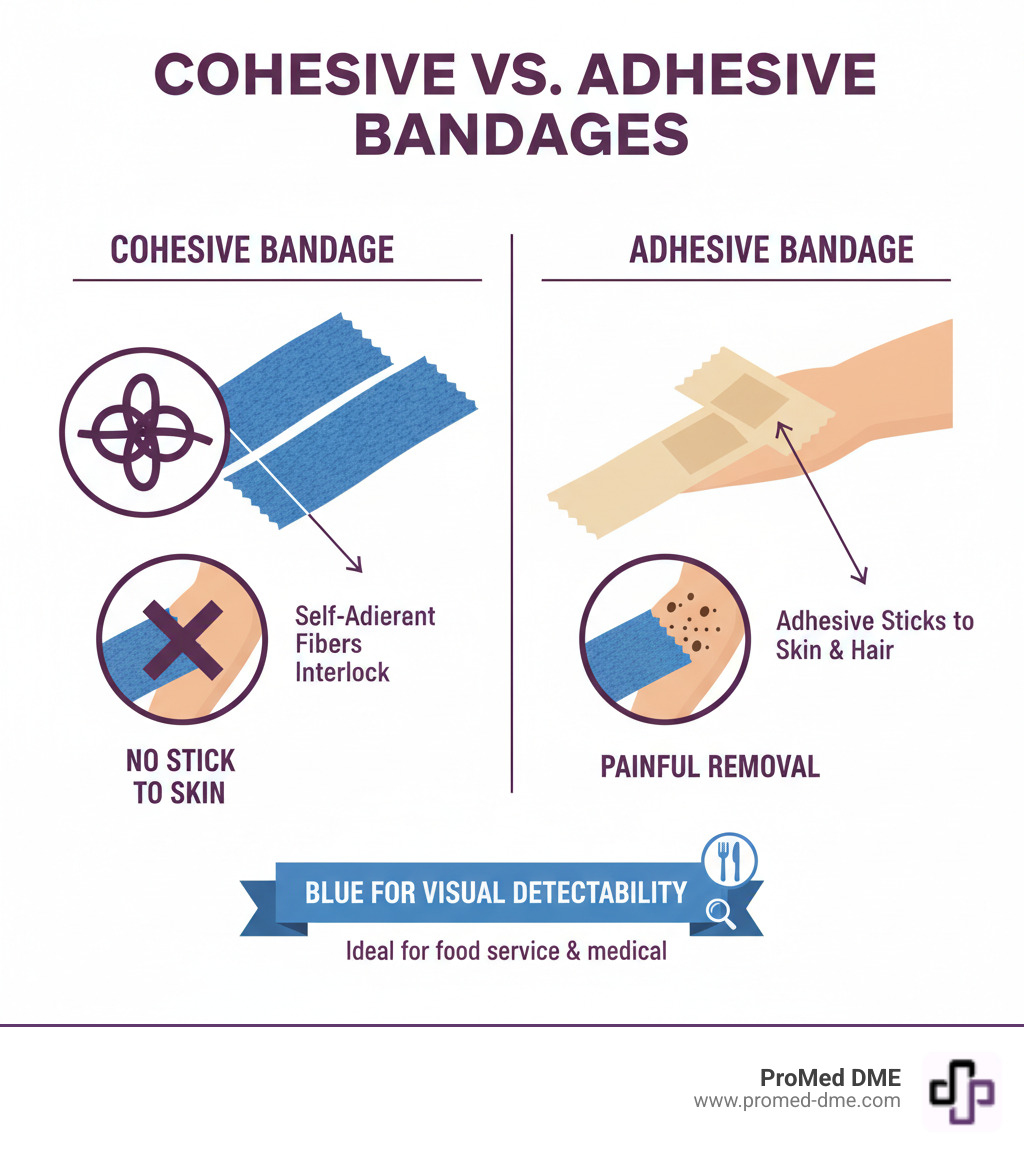
What to Look for in a Quality Blue Cohesive Bandage
Not all blue cohesive bandages are created equal. When you're dealing with an injury or securing a wound dressing, the last thing you want is a bandage that loses its grip halfway through your shift or irritates your skin.
The foundation of any great cohesive bandage starts with its material composition. Quality bandages use a blend of non-woven fibers - often cotton or synthetic materials - combined with a special methacrylate adhesive. This unique combination is what gives the bandage its signature self-adherent property, allowing it to stick firmly to itself while staying gentle on your skin.
Elasticity and stretch are where the magic happens. A good blue cohesive bandage should provide consistent compression that moves with you. It needs enough give to wrap comfortably around joints and curves, but enough memory to maintain that perfect level of support throughout the day. Think of it like a reliable friend - always there when you need it, but never clingy.
Don't overlook breathability and porosity. Your skin needs to breathe, especially when it's healing. Quality cohesive bandages are designed with tiny pores that allow air circulation while keeping everything secure. This prevents that uncomfortable, sweaty feeling that can lead to skin irritation during extended wear.
Water-resistance is a game-changer, especially in busy environments. While not completely waterproof, good cohesive bandages maintain their hold even when exposed to moisture. Whether you're washing dishes or caught in a light rain, your bandage stays put.
Here's something we absolutely love about quality cohesive bandages: they're hand-tearable. No fumbling for scissors when you need to apply one quickly. Just tear it to the exact size you need and you're good to go. It's one of those simple conveniences that makes a real difference in your day.
Product spec sheets typically highlight these key features, making it easier to compare different options and find the perfect match for your needs.
The Importance of Latex-Free Options
Here's something that might surprise you: latex allergies affect more people than you'd think, and the reactions can range from mild skin irritation to serious medical emergencies. For an overview of symptoms, causes, and prevention, see Latex allergy.
Latex allergies can cause uncomfortable skin reactions like rashes, hives, or even more severe responses. For healthcare workers, food service employees, or anyone who uses bandages regularly, this isn't just about comfort - it's about safety.
The good news? Modern hypoallergenic materials work just as well as traditional latex options. Many manufacturers now clearly label their products as "Not Made with Natural Rubber Latex," giving you peace of mind whether you're buying for yourself, your family, or your workplace.
These latex-free alternatives use synthetic materials that deliver the same excellent self-adherent properties without the worry. They're safe for sensitive skin and perfect for environments where you might not know everyone's allergy status.
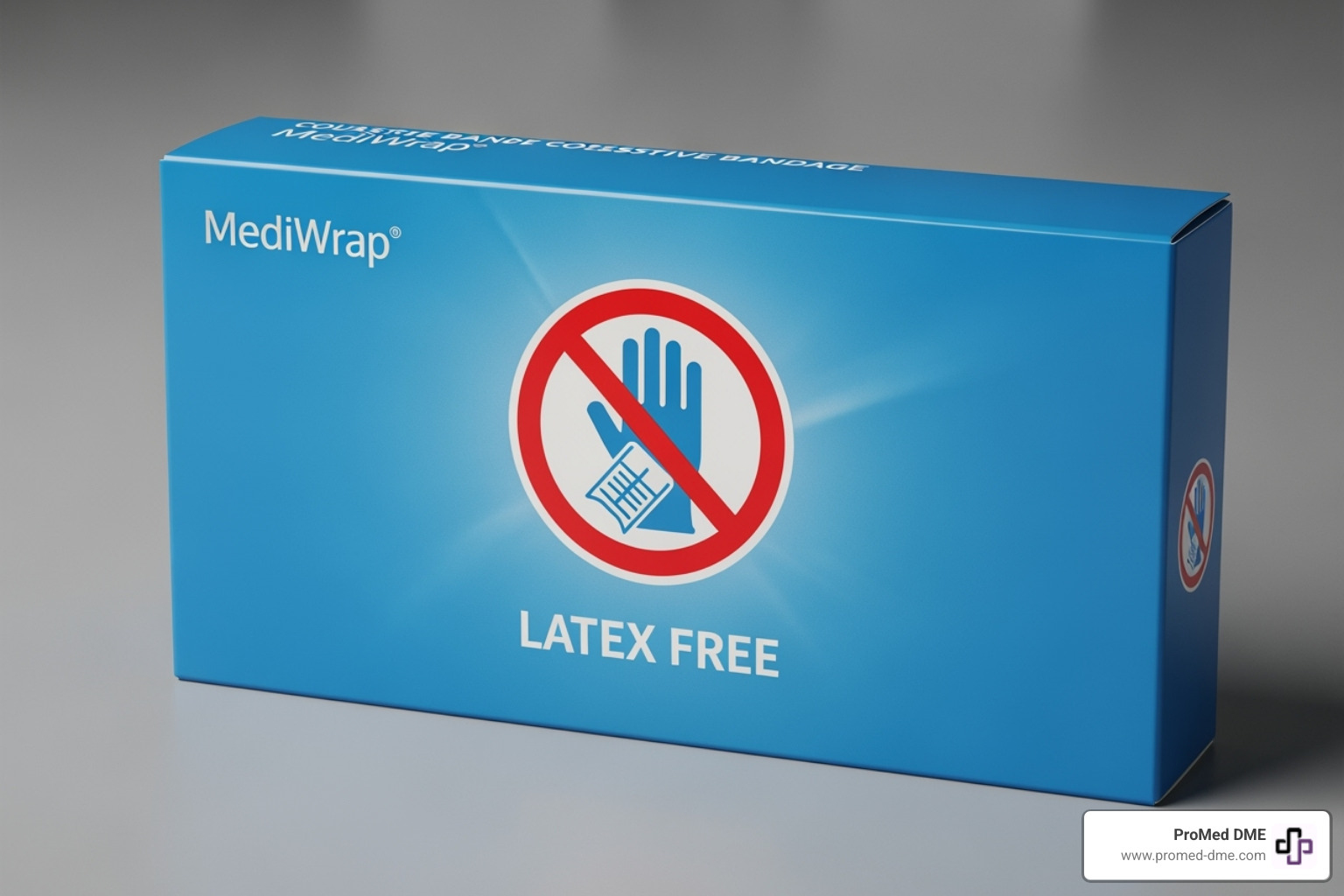
Understanding Compression Levels
One of the biggest advantages of a blue cohesive bandage is its ability to provide just the right amount of compression. But here's the thing - not every situation calls for the same level of pressure.
Standard compression is your go-to choice for most situations. It's perfect for supporting sprains and strains, providing that firm, steady pressure that helps stabilize injured areas and reduce edema. This level also excels at securing dressings without needing clips or tape - the bandage does all the work for you.
Low compression takes a gentler approach. This lighter pressure is ideal when you need mild support or when working with fragile skin. It's particularly useful for reducing edema in situations where aggressive compression might do more harm than good.
The key is finding that sweet spot - snug enough to be effective, but never so tight that it causes discomfort or restricts blood flow. A properly applied cohesive bandage should feel secure and supportive, not like it's cutting off your circulation.
Why Blue? Key Industries and Applications
You might wonder why we're making such a big deal about the color blue. After all, isn't a bandage just a bandage? Well, not quite. The distinctive blue color of these blue cohesive bandages serves a vital safety purpose that goes far beyond aesthetics.
The magic word here is visual detectability. When something is bright blue, it stands out like a sore thumb (pun intended!) in most environments. This isn't just convenient—it's a critical safety feature that can prevent serious problems in certain industries.
Think about it: if a piece of bandage accidentally falls off, you want to spot it immediately. A skin-colored or white bandage might blend into the background, but a bright blue one? You'll see it right away. This quick detection prevents contamination, ensures safety protocols are maintained, and gives everyone peace of mind.
This detectability makes blue cohesive bandages absolutely essential in food safety compliance settings. Whether we're talking about a busy restaurant kitchen, a large-scale food processing plant, or a small catering business, the risk of foreign object contamination is always present. A blue bandage that accidentally comes loose can be spotted and removed instantly, preventing it from ending up where it shouldn't.
The color choice is equally important in veterinary medicine. When you're treating animals with various fur colors, a blue bandage provides clear visibility that makes monitoring much easier. Whether it's a golden retriever or a black cat, that blue wrap will stand out clearly.
Medical and clinical settings also benefit from this visibility feature. Healthcare professionals can quickly identify bandaged areas, especially when dealing with multiple patients or complex dressings. Plus, let's be honest—a little color can brighten up an otherwise sterile environment.
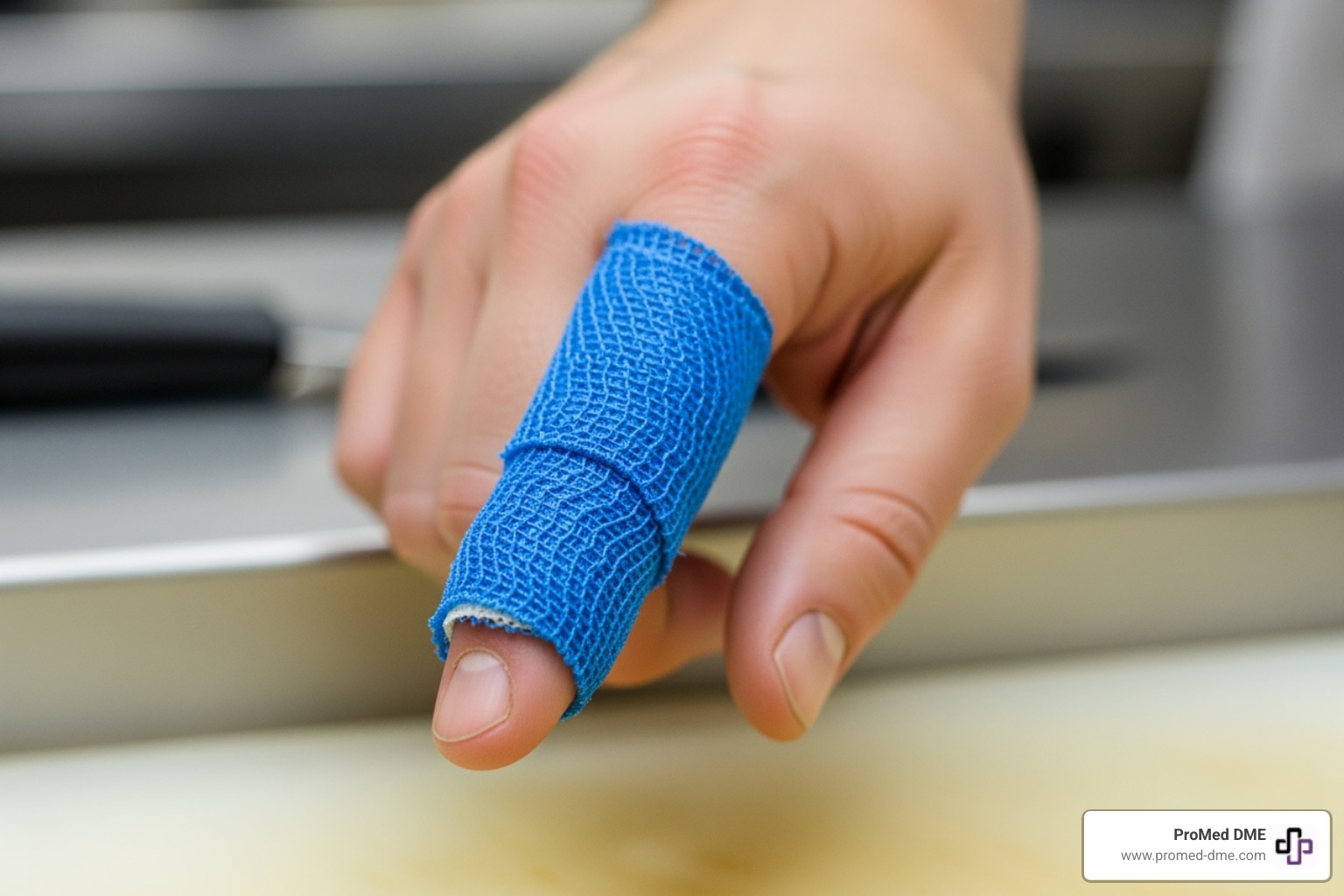
The Role of a Blue Cohesive Bandage in Food Service
In the food service world, contamination isn't just a concern—it's a nightmare scenario that can shut down businesses and make people seriously ill. This is where the blue cohesive bandage becomes a true hero in the kitchen.
Picture this: you're working the lunch rush in a busy commercial kitchen. Your knife slips, you get a small cut, and you quickly wrap it with a bandage. Hours later, that bandage works loose without you noticing. If it were flesh-colored or clear, it could easily disappear into the food prep without anyone being the wiser. But with a bright blue bandage? It's going to stick out like a guide against virtually any food item you can imagine.
This immediate visual detection isn't just helpful—it's often required by food safety standards. Many health departments and food safety protocols specifically recommend or mandate blue bandages for food handlers. It's such a simple solution to a potentially serious problem.
The beauty of cohesive bandages in food service goes beyond just the color. Since they don't have sticky adhesive that touches your skin, they're less likely to harbor bacteria or create skin irritation during long shifts. They stay put better than regular bandages, which means fewer incidents of bandages coming loose in the first place.
Whether you're running a commercial kitchen, working in a food processing plant, or managing catering safety standards, blue cohesive bandages are an essential part of your safety toolkit. They protect both your customers and your business reputation.
A Blue Cohesive Bandage in Veterinary and Pet Care
Our four-legged friends present unique challenges when it comes to wound care and injury support. They can't tell us when something hurts, they don't understand why they shouldn't lick their wounds, and they certainly don't sit still for medical procedures. That's where blue cohesive bandages really shine in veterinary and pet care settings.
The visibility on fur is probably the most obvious advantage. Whether you're dealing with a chocolate lab, a white Persian cat, or even a colorful parrot, that bright blue bandage is going to stand out clearly. This makes it so much easier for both veterinarians and pet owners to monitor the bandage's condition and ensure it's still doing its job.
But the benefits go much deeper than just being easy to see. These bandages excel at animal wound care because they don't stick to fur the way adhesive bandages do. Anyone who's ever tried to remove tape from a furry pet knows what a traumatic experience that can be—for both the animal and the owner!
The self-adherent properties make them perfect for securing splints on animals or holding dressings in place without causing pain during removal. Some specialized versions even have anti-lick properties with a bitter coating that discourages pets from chewing or licking at their injuries—a common problem that can slow healing and cause infections.
The cohesive nature means the bandage moves with your pet as they walk, run, or play, providing consistent support without slipping or bunching up. This is especially important for active animals who won't slow down just because they're wearing a bandage.
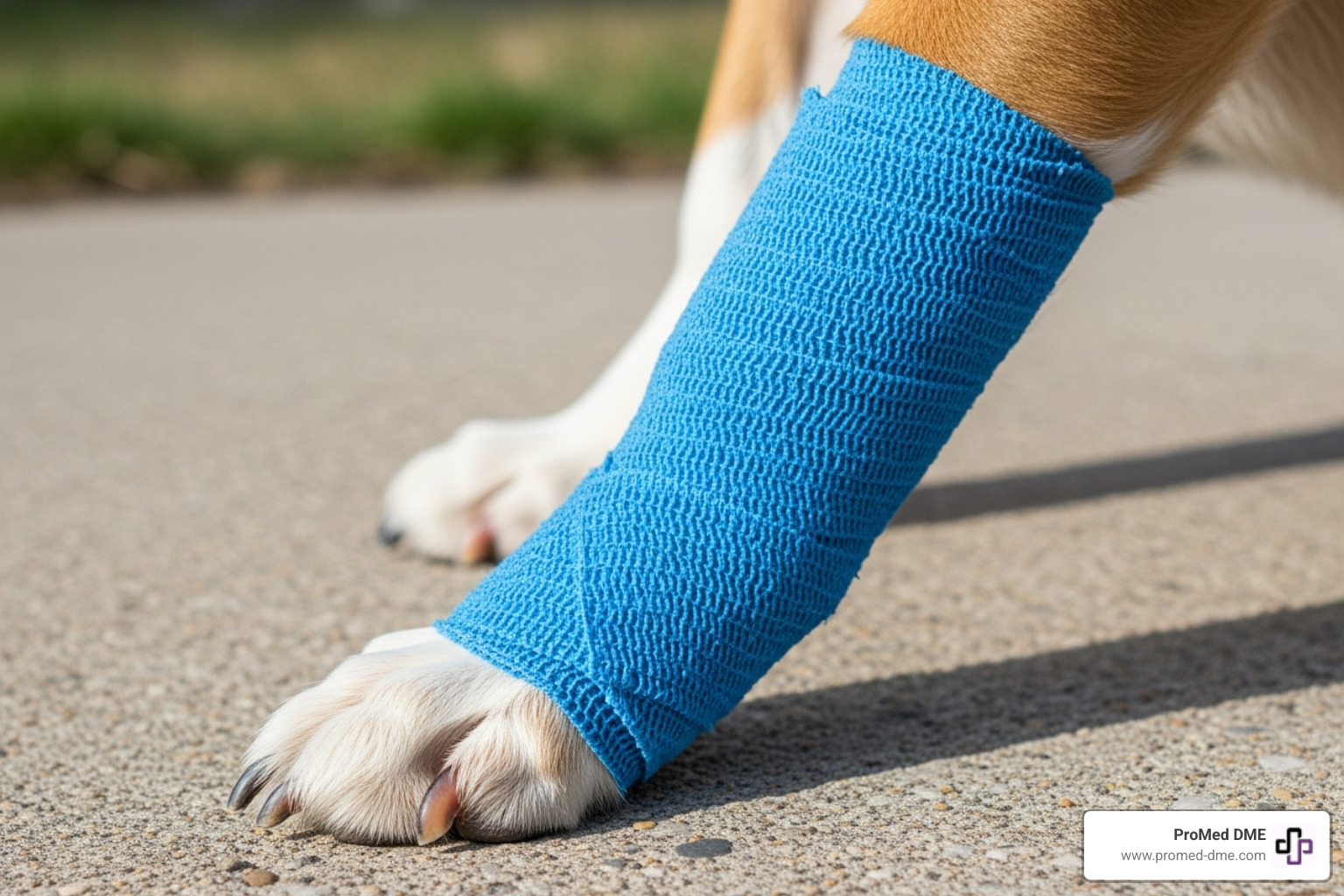
How to Properly Apply and Remove Your Bandage
Getting the most out of your blue cohesive bandage starts with proper application. Don't worry – it's easier than you might think, and once you get the hang of it, you'll wonder how you ever managed without these handy wraps.
The first thing we always tell people is to start with clean, dry skin. If you're dealing with a wound, make sure it's properly covered with a sterile dressing first. The cohesive bandage is great for securing that dressing, but it's not meant to go directly on open wounds.
Here's where the magic happens: gently unroll your bandage and estimate how much you'll need. Since these are hand-tearable, you won't be hunting around for scissors. Just tear off what you need with your hands – it's that simple.
Start your wrap a few inches below the area you're treating. This gives you a solid foundation to build on. As you wrap, overlap each layer by about half to two-thirds of the bandage width. Think of it like shingling a roof – each layer supports the next.
Now comes the most important part: getting the tension just right. We can't stress this enough – snug is good, but tight is trouble. Your bandage should feel supportive, not restrictive. A good test is the two-finger rule: you should be able to slide two fingers comfortably under the wrapped bandage.
If you notice any throbbing, numbness, tingling, or skin discoloration below the bandage, that's your body telling you it's too tight. Don't ignore these warning signs – unwrap and start over with gentler pressure.
Continue wrapping upward, covering your injury and extending a few inches beyond it. When you're done, simply press the end onto the previous layer. The self-adherent properties will do the rest – no clips, no tape, no fuss.
After you're all wrapped up, take a moment to check the area below the bandage. Look for any signs that circulation might be compromised, like coldness or pale skin. Your fingers and toes should stay their normal color and temperature.
Removal is the easy part – and honestly, one of our favorite features of cohesive bandages. Just find an edge and gently unwrap. No painful pulling, no sticky residue, no hair removal you didn't ask for. It's genuinely painless.
We always recommend treating these as single-use items. While they're incredibly durable during use, reusing them can lead to hygiene issues and reduced effectiveness. The elastic properties that give you consistent compression can weaken with repeated use, and let's be honest – nobody wants to risk cross-contamination when it comes to wound care.
Step-by-Step Application Summary:
- Clean and dry the skin thoroughly
- Cover any wounds with sterile dressing
- Start wrapping below the treatment area
- Overlap layers by half to two-thirds width
- Maintain gentle, consistent tension
- Work upward past the injury site
- Press the end to secure
- Check circulation and adjust if needed
Getting comfortable with your blue cohesive bandage application takes just a little practice, but the payoff in comfort and effectiveness is worth it.
Choosing the Right Size and Where to Purchase
Finding the perfect blue cohesive bandage means getting the size right for your specific needs. Think of it like buying clothes - you wouldn't wear a size extra-large shirt if you need a medium, and the same principle applies here. The width of your bandage should match the area you're treating to ensure proper coverage and effective compression.
Most cohesive bandages come in standard widths, and each serves different purposes. 1-inch bandages work beautifully for delicate areas like fingers, toes, and wrists - perfect when you need to secure a small dressing or provide gentle support to those easily-injured spots. Moving up, 2-inch bandages are the Swiss Army knife of the cohesive bandage world. They're incredibly versatile for hands, wrists, ankles, and small arms, making them ideal for common sprains or securing medium-sized dressings.
When you're dealing with larger joints like knees, elbows, or calves, 3-inch bandages give you that broader coverage and more substantial support you need. For bigger areas - think thighs, shoulders, or when you need extensive muscle coverage - 4-inch bandages are your best friend. Some manufacturers even offer 6-inch options for very large areas or specialized compression needs.
Here's what's great about standardization: nearly all blue cohesive bandages come in 5-yard lengths (about 4.5 meters when stretched). This gives you plenty of material for multiple wraps, even on larger limbs, so you won't find yourself running short mid-application.
| Bandage Width | Typical Uses |
|---|---|
| 1 inch | Fingers, toes, wrists, and small joints - perfect for securing small dressings |
| 2 inch | Hands, wrists, ankles, small arms - great for sprains and medium dressings |
| 3 inch | Knees, elbows, calves - broader coverage for larger joints |
| 4 inch | Thighs, shoulders, extensive muscle areas - substantial support coverage |
When it comes to buying these bandages, you have choices that fit your needs and budget. If you're stocking a home first-aid kit, single rolls make perfect sense. But if you're running a veterinary clinic, managing a restaurant kitchen, or outfitting a sports team, bulk cases containing 12 to 36 rolls offer much better value per roll.
The cost of your blue cohesive bandage depends on several factors. Brand reputation plays a role - established manufacturers often charge slightly more because they've proven their quality over time. Size matters too - wider, longer rolls naturally cost more than their smaller counterparts. If you need latex-free options (which we highly recommend), you might pay a small premium for the specialized materials, but the peace of mind is worth it.
Bulk purchasing almost always saves you money per roll compared to buying individually. We've seen single rolls range from a few dollars to around $15, but when you buy cases, that per-roll cost drops significantly. Always compare unit prices to make sure you're getting the best deal.
At ProMed DME, we understand that finding quality medical supplies shouldn't be complicated or expensive. Based right here in Stuart, Florida, we ship across the entire United States and take pride in being your trusted source for blue cohesive bandages and other essential medical supplies.
What sets us apart? We offer free shipping on all orders because we believe healthcare supplies should be accessible. We have a dedicated nurse on staff who can answer your questions about product selection or proper application - no automated responses, just real expertise from someone who understands your needs. Plus, we work with most insurance plans to help minimize your out-of-pocket expenses.
Whether you need a single roll for your home medicine cabinet or bulk quantities for your business, we're committed to delivering top-quality products with the exceptional customer service you deserve. After all, when it comes to wound care and safety, you shouldn't have to compromise on quality or convenience.
Frequently Asked Questions about Blue Cohesive Bandages
We love hearing from our customers about blue cohesive bandages! Over the years, we've noticed the same helpful questions come up again and again. Let's explore the most common ones to help you get the most out of these amazing wraps.
How should I store cohesive bandages to maintain their quality?
Think of your blue cohesive bandage like a good bottle of wine - it needs the right environment to stay at its best! The key is keeping them in a cool, dry place where they won't get too hot or humid. We've seen bandages lose their stick when they've been sitting in a hot car or steamy bathroom for too long.
Direct sunlight is another enemy of cohesive bandages. Those UV rays can break down the materials and even fade that distinctive blue color over time. Nobody wants a purple bandage when they need a blue one for food safety!
Here's something many people don't think about: keep them in their original packaging until you're ready to use them. That wrapper isn't just there to look pretty - it protects the bandage from dust, moisture, and accidental sticking to other items in your first-aid kit.
Most cohesive bandages have a pretty generous shelf life, but it's always smart to check any dates on the packaging when you're organizing your medical supplies. Store them properly, and they'll be ready to perform when you need them most.
Can cohesive bandages be reused?
We get this question a lot, especially from folks who hate to waste anything! While we appreciate the environmentally conscious thinking, cohesive bandages are designed for single-use only. Here's why trying to reuse them isn't worth the risk.
The biggest concern is cross-contamination. Even if your bandage wasn't directly touching a wound, it's been in contact with skin, clothing, and whatever else was in the environment. Bacteria love to hitchhike on medical supplies, and reusing a bandage can introduce germs where you definitely don't want them.
There's also the performance issue. Once you've stretched and used a blue cohesive bandage, it starts to lose its elasticity. Think of it like a rubber band that's been stretched too many times - it just doesn't snap back the way it should. This means less compression and support when you need it most.
Finally, that amazing self-adhesion property that makes these bandages so convenient? It reduces with handling and exposure. A used bandage might not stick to itself as reliably, which could mean it slips or comes loose at the worst possible moment.
For the best results and peace of mind, always reach for a fresh bandage each time you need one.
How tight should a cohesive bandage be?
Getting the tension just right on your blue cohesive bandage is like finding the perfect fit for a pair of shoes - snug but not constricting. You want to feel supported and secure, but never uncomfortable or restricted.
We always teach our customers the two-finger rule. After you've applied your bandage, try sliding two fingers underneath the edge of the wrap. If they fit comfortably, you're in the sweet spot. If it's hard to get them under there, you've wrapped too tightly.
Your body will usually tell you pretty quickly if something's wrong. Watch out for numbness or tingling - that pins-and-needles feeling is your body's way of saying "Hey, loosen up!" Discoloration is another red flag. If the skin below your bandage starts looking pale, bluish, or purple, that bandage needs to come off immediately.
Sometimes people are surprised when their wrapped area feels colder than usual or when they notice increased pain or swelling. Counterintuitively, a bandage that's too tight can actually make swelling worse by preventing proper circulation.
If you notice any of these warning signs, don't wait - remove the bandage right away and rewrap it more loosely. It's always better to err on the side of slightly too loose than too tight. After all, we want that blue cohesive bandage to help you heal, not cause new problems!
Conclusion
Throughout this guide, we've finded just how remarkable blue cohesive bandages truly are. These aren't just ordinary wraps - they're problem-solvers that bring together comfort, safety, and effectiveness in one simple package.
We've seen how their self-adherent magic works, sticking firmly to themselves while being gentle on skin and hair. No more wincing during removal or dealing with sticky residue! The breathable, stretchy material provides just the right amount of support whether you're wrapping a sprained ankle or securing a wound dressing.
The blue color isn't just pretty - it's practical genius. In busy kitchens, veterinary clinics, and medical facilities, that bright blue stands out like a guide, preventing contamination and keeping everyone safer. It's amazing how such a simple color choice can make such a big difference in food safety and patient care.
From the latex-free options that protect sensitive skin to the various compression levels that suit different needs, these bandages prove their versatility time and again. Whether you're a restaurant manager ensuring food safety compliance, a pet owner caring for an injured furry friend, or someone dealing with a sports injury, there's a blue cohesive bandage that fits your specific situation perfectly.
The proper application techniques we've covered - from the two-finger rule to recognizing signs of over-tightening - help ensure you get maximum benefit safely. And with the right storage practices, your bandages will be ready to perform whenever you need them.
Quality matters when it comes to medical supplies, and that's where having a trusted partner makes all the difference. At ProMed DME, we understand that your health and safety are priorities, not afterthoughts. Our commitment goes beyond just selling products - we're here to support you with expert guidance, exceptional service, and the peace of mind that comes from working with professionals who truly care.
Ready to experience the difference that quality blue cohesive bandages can make? Let us help you find exactly what you need.
Related Resources & Articles
Stay informed with our informative blog posts.
Discover the ProMed Advantage
& Try Our Products
We offer free shipping and legendary customer service to ensure you receive the
best DME products for your needs.

